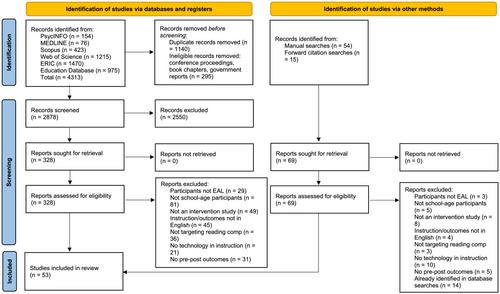Digital literacy instruction is increasingly common in contemporary practices and can accommodate learners with a range of needs. This systematic review explores the use and effects of technology during reading comprehension instruction involving school-aged children learning English as an additional language (EAL). Our aim was to provide broad, global coverage that reflects the state of research in the field.
We searched databases using terms related to EAL, reading comprehension and digital literacy instruction to identify relevant studies published on the topic between 2010 and 2023. Data were extracted regarding study context, participant characteristics, methodology, instruction characteristics and outcomes. We quantified the outcomes of instruction using standardised measures of effect size where possible and appraised the research quality of each study.
A total of 4382 studies were identified. Of these, 53 met our inclusion criteria. Studies were conducted across a variety of low- and high-resource environments, including countries where English is a majority language and those where it is a non-majority language. Learners from kindergarten through 11th grade were included across the studies. A range of reading comprehension strategies were utilised within the context of digital instruction, with multiple-strategy instruction the most common. Digital instruction resulted in statistically significant gains in reading comprehension in 32 studies (small to large effect sizes). Our research quality analysis revealed variability in terms of rigour, further adding to the diversity across studies. We conducted a sub-analysis of eight studies that met the highest standards of research quality. Like the full set of 53 studies, these eight studies reported on diverse types of digital instruction and diverse reading comprehension outcomes but tended to result in smaller effect sizes.
Digital reading comprehension instruction can result in reading comprehension gains for children learning EAL, though findings are mixed. Further high-quality research is needed.



